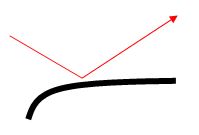Tuning Fork AFM
AFM Feedback

This feedback method is laser-free meaning that there is no interference with lasers or signal from an optical experiment. Also, typical quality factors of the tuning forks are very high at ~11000, providing ultra-sensitive feedback for experiments like force spectroscopy that may require it. Finally, cantilevers mounted on tuning forks can avoid discontinuities when approaching the surface, namely the jump to contact (typical for optical beam deflection based feedback and soft probes). This is especially important for force spectroscopic measurements that probe details in the approach curves.
STM Feedback
STM probes can be mounted onto tuning forks too for different experimental configurations such as TERS or surface plasmon excitation. AFM feedback, based on the tuning fork oscillations, can be used to maintain a constant tip-sample distance using the tuning fork's amplitude, phase, or frequency. STM probes operated in this mode still benefit from the laser-free feedback and a very stiff spring constant that avoids jump to contact instabilities, as described above for conventional cantilevers mounted on tuning forks. However, STM probes can also be run with "STM feedback" where now the feedback mechanism to keep the tip-sample distance constant is based on keeping a constant tunneling current between the probe and sample. Functionally, this means that voltage (from the SPM controller) is applied to the probe. The probe and sample are then connected to the signal amplifier and the output signal from the ampifier is then measured. On Nanonics systems, the switch to STM feedback requires a simple switch of a single BNC cable. Note that STM feedback can only be used on conducting or semiconducting surfaces.
Fiber Probes
Fiber based probes can also be mounted onto tuning forks for a variety of experiments including TERS. There are two kinds of feedback mechanisms that can be implemented for fiber probes mounted on a tuning fork: 1) AFM-based feedback which uses the amplitude, frequency, or phase of the tuning fork to maintain a constant tip-sample distance and 2) STM-based feedback for fiber based probes with a thin conductive coating. In this case, the tunneling current between the probe and sample is the source of feedback to maintain a constant tip-sample distance. With AFM feedback, the fiber probes with tuning fork actuation benefit from the laser-free feedback and a very stiff spring constant that avoids jump to contact instabilities, as described above for conventional cantilevers mounted on tuning forks. AFM-feedback can be used on all kinds of samples - insulating, conducting, or semiconducting.
Laser or optical based method

This conventional method of normal force feedback has serious drawbacks for integration of SPM with optical methods. First, the laser involved introduces an optical background that is often unwanted and interferes with the optical signal being measured. Second, the configuration of the optical feedback system imposes a geometrical constraint on the instrument, especially for multiprobe experiments.
Shear force feedback method
With this method, straight probes are mounted onto vertically oriented tuning forks, as shown in the schematic above. The tuning fork then dithers the tip laterally where the shear force between the tip and the sample is the feedback parameter to control the tip-sample distance. This method often induces tip breakage and damage, and exhibits poor sensitivity to tip-sample forces. Furthermore, the interactions underlying shear force imaging are poorly understood. This leads to artifacts from the convolution of shear force with material properties of the substrate. Finally, straight fibers used with shear force feedback cannot be used for optical measurements where they obscure the optical axis from the top; these measurements include true NSOM reflection, fluorescence, and AFM/Raman in reflection mode.

